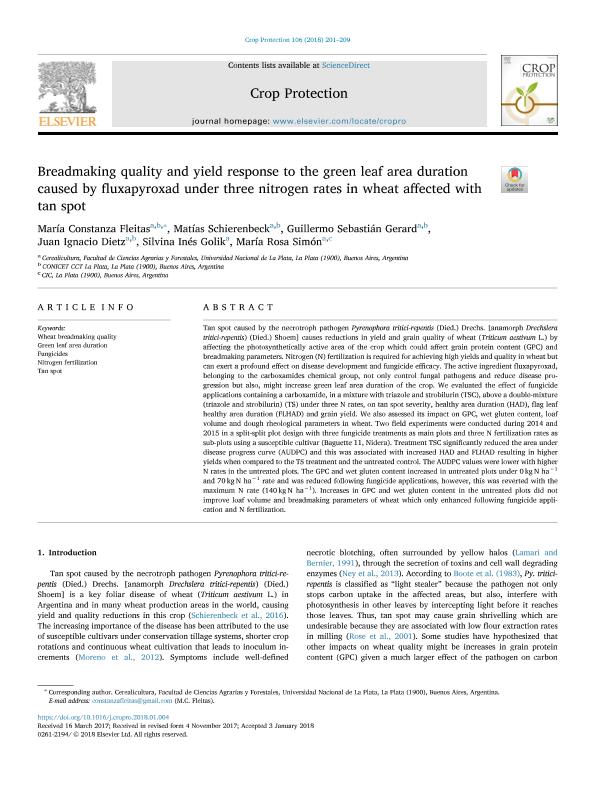Mostrar el registro sencillo del ítem
dc.contributor.author
Fleitas, María Constanza

dc.contributor.author
Schierenbeck, Matías

dc.contributor.author
Gerard, Guillermo Sebastián

dc.contributor.author
Dietz, Juan Ignacio

dc.contributor.author
Golik, Silvina Ines

dc.contributor.author
Simon, Maria Rosa

dc.date.available
2020-04-03T16:02:23Z
dc.date.issued
2018-04
dc.identifier.citation
Fleitas, María Constanza; Schierenbeck, Matías; Gerard, Guillermo Sebastián; Dietz, Juan Ignacio; Golik, Silvina Ines; et al.; Breadmaking quality and yield response to the green leaf area duration caused by fluxapyroxad under three nitrogen rates in wheat affected with tan spot; Elsevier; Crop Protection; 106; 4-2018; 201-209
dc.identifier.issn
0261-2194
dc.identifier.uri
http://hdl.handle.net/11336/101831
dc.description.abstract
Tan spot caused by the necrotroph pathogen Pyrenophora tritici-repentis (Died.) Drechs. [anamorph Drechslera tritici-repentis) (Died.) Shoem] causes reductions in yield and grain quality of wheat (Triticum aestivum L.) by affecting the photosynthetically active area of the crop which couldaffect grain protein content (GPC) and breadmaking parameters. Nitrogen (N) fertilization is required for achieving high yields and quality in wheat but can exert a profound effect on disease development and fungicide efficacy. The active ingredient fluxapyroxad, belonging to the carboxamides chemical group, not only control fungal pathogens and reduce disease progression but also, might increase green leaf area duration of the crop. We evaluated the effect of fungicide applications containing a carboxamide, in a mixture with triazole and strobilurin (TSC), above a double-mixture (triazole and strobilurin) (TS) under three N rates, on tan spot severity, healthy area duration (HAD), flag leaf healthy area duration (FLHAD) and grain yield. We also assessed its impact on GPC, wet gluten content, loaf volume and dough rheological parameters in wheat. Two field experiments were conducted during 2014 and 2015 in a split-split plot design with three fungicide treatments as main plots and three N fertilization rates as sub-plots using a susceptible cultivar (Baguette 11, Nidera). Treatment TSC significantly reduced the area under disease progress curve (AUDPC) and this was associated with increased HAD and FLHAD resulting in higher yields when compared to the TS treatment and the untreated control. The AUDPC values were lower with higher N rates in the untreated plots. The GPC and wet gluten content increased in untreated plots under 0 kg N ha-1 and 70 kg N ha-1 rate and was reduced following fungicide applications, however, this was reverted with the maximum N rate (140 kg N ha-1). Increases in GPC and wet gluten content in the untreated plots did not improve loaf volume and breadmaking parameters of wheat which only enhanced following fungicide application and N fertilization.
dc.format
application/pdf
dc.language.iso
eng
dc.publisher
Elsevier

dc.rights
info:eu-repo/semantics/openAccess
dc.rights.uri
https://creativecommons.org/licenses/by-nc-sa/2.5/ar/
dc.subject
WHEAT BREADMAKING QUALITY
dc.subject
GREEN LEAF AREA DURATION
dc.subject
FUNGICIDES
dc.subject
NITROGEN FERTILIZATION
dc.subject
TAN SPOT
dc.subject.classification
Agronomía, reproducción y protección de plantas

dc.subject.classification
Agricultura, Silvicultura y Pesca

dc.subject.classification
CIENCIAS AGRÍCOLAS

dc.title
Breadmaking quality and yield response to the green leaf area duration caused by fluxapyroxad under three nitrogen rates in wheat affected with tan spot
dc.type
info:eu-repo/semantics/article
dc.type
info:ar-repo/semantics/artículo
dc.type
info:eu-repo/semantics/publishedVersion
dc.date.updated
2020-04-02T13:55:38Z
dc.journal.volume
106
dc.journal.pagination
201-209
dc.journal.pais
Países Bajos

dc.journal.ciudad
Amsterdam
dc.description.fil
Fil: Fleitas, María Constanza. Universidad Nacional de La Plata. Facultad de Ciencias Agrarias y Forestales. Cátedra de Cerealicultura; Argentina. Consejo Nacional de Investigaciones Científicas y Técnicas. Centro Científico Tecnológico Conicet - La Plata; Argentina
dc.description.fil
Fil: Schierenbeck, Matías. Universidad Nacional de La Plata. Facultad de Ciencias Agrarias y Forestales. Cátedra de Cerealicultura; Argentina. Consejo Nacional de Investigaciones Científicas y Técnicas. Centro Científico Tecnológico Conicet - La Plata; Argentina
dc.description.fil
Fil: Gerard, Guillermo Sebastián. Consejo Nacional de Investigaciones Científicas y Técnicas. Centro Científico Tecnológico Conicet - La Plata; Argentina. Universidad Nacional de La Plata. Facultad de Ciencias Agrarias y Forestales. Cátedra de Cerealicultura; Argentina
dc.description.fil
Fil: Dietz, Juan Ignacio. Consejo Nacional de Investigaciones Científicas y Técnicas. Centro Científico Tecnológico Conicet - La Plata; Argentina. Universidad Nacional de La Plata. Facultad de Ciencias Agrarias y Forestales. Cátedra de Cerealicultura; Argentina
dc.description.fil
Fil: Golik, Silvina Ines. Universidad Nacional de La Plata. Facultad de Ciencias Agrarias y Forestales. Cátedra de Cerealicultura; Argentina. Consejo Nacional de Investigaciones Científicas y Técnicas. Centro Científico Tecnológico Conicet - La Plata; Argentina
dc.description.fil
Fil: Simon, Maria Rosa. Consejo Nacional de Investigaciones Científicas y Técnicas. Centro Científico Tecnológico Conicet - La Plata; Argentina. Universidad Nacional de La Plata. Facultad de Ciencias Agrarias y Forestales. Cátedra de Cerealicultura; Argentina
dc.journal.title
Crop Protection

dc.relation.alternativeid
info:eu-repo/semantics/altIdentifier/url/http://linkinghub.elsevier.com/retrieve/pii/S0261219418300048
dc.relation.alternativeid
info:eu-repo/semantics/altIdentifier/doi/http://dx.doi.org/10.1016/j.cropro.2018.01.004
Archivos asociados
